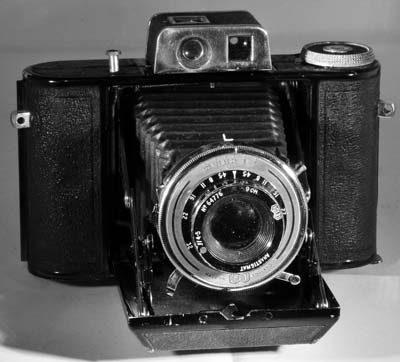Agilux Agifold
Specification

| Manufacturer | : | Agilux |
|---|---|---|
| Produced | : | 1948 |
| Classification | : | Medium Format |
| Body Type | : | Folding Bed |
| Bellows Deployment | : | Self Erecting |
| Construction | : | Metal |
| Film Type | : | 120/620 |
| Film Width | : | 62mm |
| Image Size | : | 5.7 x 5.5 cm |
| No. of Images | : | 12 |
| Lens Type | : | Anastigmat |
| Focal Length | : | 90mm |
| Focus Type | : | Variable |
| Focal Range | : | 3.5ft - inf. |
| Aperture Type | : | Iris |
| Apertures | : | f/4.5 - f/32 |
| Shutter Type | : | AGI |
| Shutter Speeds | : | T,B, I(1/125s, 1/100s, 1/50s, 1/25s) |
| Size Open (w x h x d) | : | 160 x 115 x 118 mm |
| Size Closed (w x h x d) | : | 160 x 115 x 50 mm |
| Weight | : | 702g |
Art Deco Credentials
![]()
![]()
![]()
Noteworthy: Worth giving special attention
I consider this camera to warrant 3 stars for the following attributes:
- produced after the main Art Deco period;
- rounded body;
- trapizoidal viewfinder;
- chrome accents;
- chrome embellishments on base;
- chrome struts;
- chrome viewfinder;
- other chrome highlights.
Description
The Agifold is a self erecting, folding camera. It was made in Croydon, UK by Agilux. This is the base model. There were several other models - some with rangefinder, some with an extinction light meter. Lenses and shutters were made by AGI themselves.
This early version has a shutter with speeds of 1/25, 1/50, 1/100, 1/125 in instantaneous mode, together with B & T. The shutter release is located on the body which is automatically retracted as the camera is closed. It needs to be primed using a lever before firing. There is a remote shutter release port.
The f/4.5 lens is capable of focussing between 3.5ft and infinity. An iris type aperture provides apertures from f/4.5 to f/32. A scale is provided to show the range of focus for different apertures at different focus distances.
There is an eye-level viewfinder plus a waist level finder fitted together on a viewfinder block. The viewfinder block is pushed sideways to release the front of the camera.
The back features both a red and a green window with two sliders to select which to open. The red window is designed to be used with orthochromatic film and the green with panchromatic film.
The shutter is flash synchronised via two pins on the side of the lens panel.
There is a tripod mount provided on the base.
How to Use
With modern film you can use either the red or green window to advance the film. The only proviso is that you use the same one throughout the film. The windows should only be opened when winding on in subdued light.
Exposure
Shutter speeds are 1/25s, 1/50s and 1/100s and 1/125s although the accuracy is not guaranteed. The speeds of 1/100s and 1/125s can be used interchangeably producing very little difference in exposure.
If you don't want to bother with an exposure meter, follow the guide shown. It is based on the 'Sunny 16' rule. Film is so forgiving and will produce acceptable results even when overexposed by 2 or 3 stops or underexposed by 1 stop.
Remember that the exposure guide in the camera user manual may not be helpful as it is based on the use of old film with a low ISO value.
The tables assume that the sun is at least 30 degrees above the horizon - that's 10am - 5pm on a summer's day in the UK.
If you are not sure about the light level, err on the side of overexposure - i.e. assume the smaller f number.
Where there is a choice, a larger f number will give a larger depth of field.
For the slower speeds, you may need a tripod to stop blur through shake.
Using ISO 100/125 film
| Weather Conditions | Shadow Detail | Shutter Speed (s) | ||
|---|---|---|---|---|
| 1/25 | 1/50 | 1/100 | ||
 Sunny SunnySnow/Sand | Dark with sharp edges | - | 1/32 | f/22 |
 Sunny Sunny | Distinct | 1/32 | f/22 | f/16 |
 Slight Overcast Slight Overcast | Soft around edges | f/22 | f/16 | f/11 |
 Overcast Overcast | Barely visible | f/16 | f/11 | f/8 |
 Heavy Overcast Heavy Overcast | None | f/11 | f/8 | f/5.6 |
 Open Shade Open Shade/Sunset | None | f/8 | f/5.6 | f/4.5 |